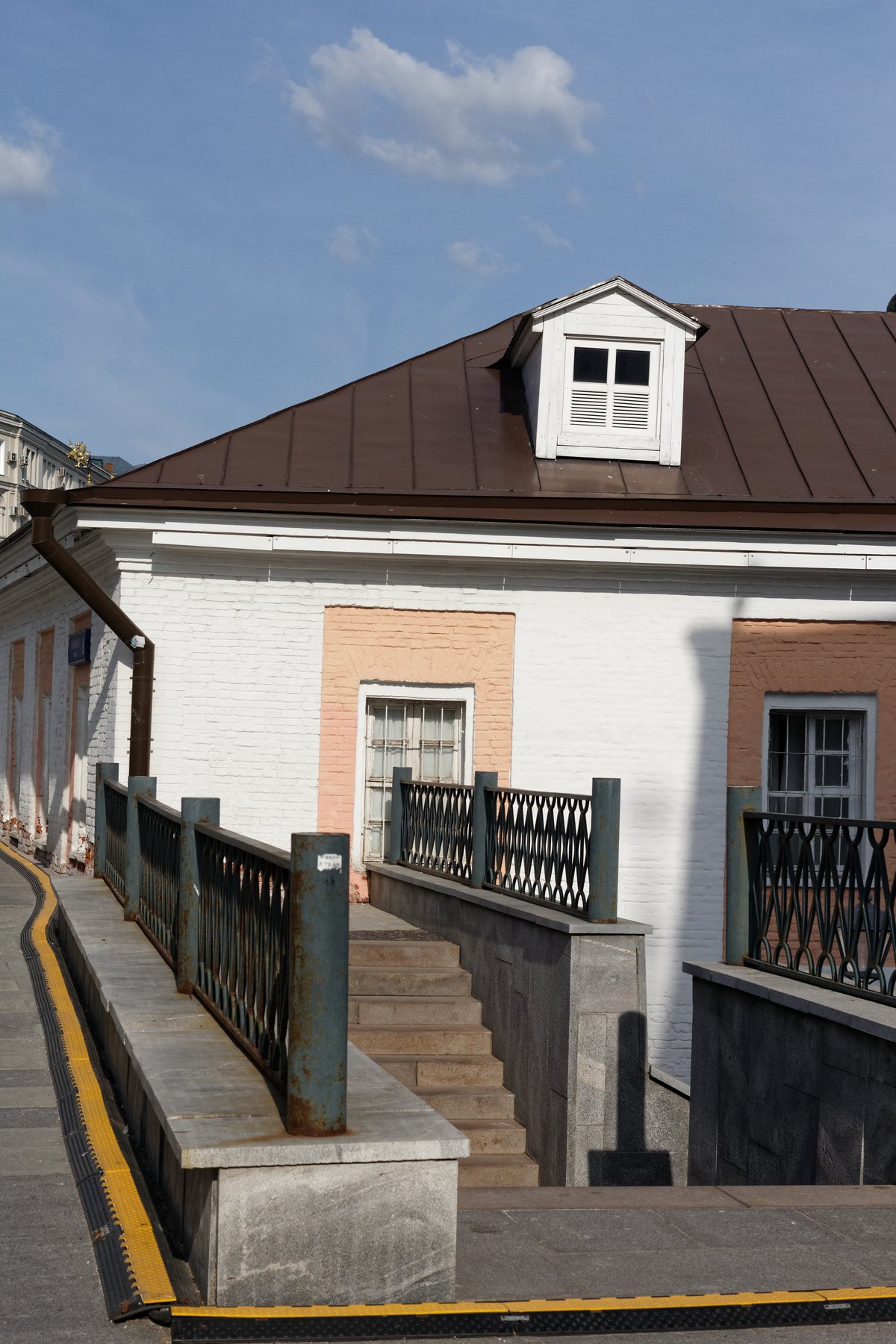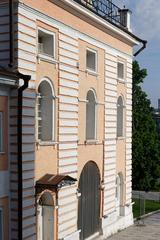
Znamensky Monastery: Visiting Hours, Tickets, and Comprehensive Guide to Moscow’s Historic Landmark
Date: 15/06/2025
Introduction
Nestled in the heart of Moscow’s Kitay-Gorod district, Znamensky Monastery stands as a distinguished monument to Russia’s religious, imperial, and architectural legacy. Also known as the Monastery of the Icon of the Mother of God “The Sign” (Znamenie), it bears centuries-old connections to the Romanov dynasty and remains a central figure in Moscow’s spiritual and cultural landscape. This detailed guide covers the monastery’s history, architectural evolution, visitor information, and practical tips—ensuring you make the most of your visit to one of Moscow’s most revered historical sites (Moscow City Guide, Official Znamensky Monastery, Life-Cheb.ru).
Historical Overview
Foundations and Romanov Legacy
Znamensky Monastery traces its roots to the early 17th century, emerging during the rise of the Romanov dynasty. The site was originally the estate of the Romanov boyars, featuring a house church dedicated to the Icon of the Mother of God “The Sign” (Znamenie), a deeply venerated family icon (Wiki7). The monastery’s founding is variously dated to 1629 or 1631—either to commemorate the passing of nun Martha, mother of Tsar Mikhail Fyodorovich, or the birth of his heir. The close ties to the Romanovs established the monastery as both a dynastic and spiritual stronghold.
Architectural Evolution
After an initial wooden construction, the monastery suffered a major fire in 1668. Stone reconstruction soon followed, led by master builders Fyodor Grigoriev and Grigory Anisimov, with funding from boyar I. M. Miloslavsky. Completed between 1679 and 1684, the five-domed Znamensky Cathedral exemplifies Moscow Baroque style, featuring a striking red-and-white façade and ornate iconostasis. Subsequent expansions included chapels and a bell tower, further enhancing the complex’s architectural grandeur (Ermak Vagus).
Historical Trials and Restoration
Znamensky Monastery endured significant challenges: it survived the 1737 Trinity Fire, looting by Napoleonic troops in 1812, and the secularization and neglect of the Soviet era. The monastery was officially dissolved in 1923; parts of the complex were demolished or repurposed. Yet restoration efforts in the 1960s and 1970s, and a major government-led revival in the 2010s, returned the cathedral and its grounds to their former splendor.
Modern Status
Since the 1990s, Znamensky Monastery has resumed its religious and cultural functions. The cathedral now serves as the main temple of the Patriarchal compound in Zaryadye, and the Romanov Chambers operate as a museum branch of the State Historical Museum. The monastery is integrated into the vibrant Zaryadye Park, making it easily accessible and inviting for both worshippers and tourists (Life-Cheb.ru).
Architectural and Artistic Highlights
- Cathedral: The five-domed Znamensky Cathedral is a masterpiece of Moscow Baroque, with white stone, red ornamentation, and gilded domes representing Christ and the Four Evangelists.
- Bell Tower: Built into the western façade, the bell tower features arched Baroque openings and serves as the main entrance.
- Interiors: The cathedral’s spacious refectory, frescoes, and surviving choir stalls reflect the artistry of 17th- and 18th-century Russia.
- Iconostasis: The multi-tiered, gilded wooden iconostasis is a focal point of the interior.
- Romanov Chambers: Adjacent to the cathedral, these restored chambers now serve as a museum showcasing Romanov family history and artifacts.
- Chapels: Dedicated to St. Athanasius of Athos, St. Sergius of Radonezh, and St. Nicholas the Wonderworker, these spaces offer additional insight into Russian Orthodox traditions (Geomerid, ReligionMystic).
Spiritual and Cultural Significance
Znamensky Monastery’s dedication to the Icon of the Mother of God “The Sign” underscores its significance in Russian Orthodoxy. The icon is associated with miraculous protection—most notably, the defense of Novgorod in the 12th century. The monastery remains a hub for Orthodox prayer, processions, and annual feast day celebrations, while also supporting cultural initiatives and historical preservation efforts (Life-Cheb.ru).
Visitor Information
Opening Hours
- General Hours: Daily, 10:00 AM – 6:00 PM (may vary on religious holidays or special events; check the official website for updates).
- Best Times to Visit: Morning and late afternoon on weekdays are quietest. Spring and early autumn provide the most pleasant weather.
Tickets and Admission
- Entry: Free for worshippers and individual visitors.
- Guided Tours & Special Exhibitions: Fees may apply (typically 200–400 RUB). Tickets can be purchased onsite or online.
- Reservations: Not required for general admission; advance booking recommended for group tours or special events.
Accessibility
- Mobility: The main cathedral and museum are partially wheelchair accessible; some historic sections have limited access due to preservation.
- Families & Groups: Children are welcome; groups over 10 should notify the monastery in advance.
Dress Code & Etiquette
- Women: Head coverings, skirts/dresses below the knee, shoulders covered.
- Men: Remove hats and avoid shorts/sleeveless tops.
- Photography: Allowed outdoors; restricted inside during services. No flash or tripods. Always check signage or ask staff (Russian Orthodox Church Visitor Guidelines).
- Behavior: Maintain silence and respect, especially during services.
Getting There
- Location: 2 Varvarka Street, Kitay-Gorod, Moscow.
- Metro: Kitay-Gorod (lines 6 & 7), Ploshchad Revolyutsii (line 3), both within a 10-minute walk.
- Other Transport: Taxi, rideshare, and multiple bus/tram lines. Parking is limited due to the central location.
Facilities and Amenities
- Restrooms: Basic facilities near the entrance.
- Gift Shop: Sells icons, candles, and religious literature.
- Café: Not available onsite; options nearby along Varvarka Street and in Zaryadye Park.
- Interpretation: Bilingual signage; English brochures available; private tours can be booked.
Liturgical Services and Events
- Services: Daily Orthodox liturgies; major celebrations during Easter, Christmas, and the feast of the Icon of the Sign (December 10).
- Visitor Participation: All are welcome; respectful observation is encouraged.
Nearby Attractions and Suggested Itineraries
- Red Square & Kremlin: 5–10 minute walk; iconic Moscow landmarks.
- Zaryadye Park: Adjacent urban park with panoramic views and a floating bridge (Zaryadye Park Official).
- St. Barbara’s Church: Historic church nearby on Varvarka Street.
- State Tretyakov Gallery: Short metro ride; premier collection of Russian art (The Broke Backpacker).
- Church of the Transfiguration: Not far, notable for Theophanes the Greek’s frescoes (Geomerid).
Suggested visit duration: 45–90 minutes; combine with nearby sites for a half-day itinerary.
Practical Tips
- Arrive early to avoid crowds.
- Dress appropriately for a religious site.
- Carry some cash for donations or gift shop purchases.
- Use a translation app or hire a local guide for deeper insight.
- Check the weather and plan your route in advance.
- Download the Audiala app for audio guides and self-guided tours.
Frequently Asked Questions (FAQ)
Q: What are the opening hours of Znamensky Monastery?
A: Generally 10:00 AM–6:00 PM daily; hours may vary on religious holidays.
Q: Is admission free?
A: Yes, entry is free. Guided tours and special exhibitions may require a ticket.
Q: Is the monastery accessible for visitors with disabilities?
A: The main cathedral and museum are partially accessible; inquire in advance for assistance.
Q: Can I take photographs?
A: Yes, in courtyards and gardens. Restrictions apply inside, especially during services.
Q: Are guided tours available?
A: Yes, private and group tours can be arranged in advance.
Q: How do I get there?
A: The monastery is located at 2 Varvarka Street, a short walk from Kitay-Gorod and Ploshchad Revolyutsii metro stations.
Visuals and Media Recommendations
- Exterior: Capture the vibrant red-and-white Baroque façade and five domes.
- Interior: Seek detailed shots of the iconostasis and 17th-century frescoes (where permitted).
- Maps: Use interactive maps from official travel sites to plan your route.
- Virtual Tours: Explore panoramic views on the monastery’s official website.
Summary
Znamensky Monastery is a living testament to Moscow’s religious, imperial, and architectural history. From its Romanov roots and Baroque splendor to its endurance through hardship and vibrant modern revival, it offers visitors an immersive experience in the heart of Russia’s capital. Free entry, rich programming, and proximity to other major attractions make Znamensky Monastery a must-see for anyone exploring Moscow’s storied core. For the latest updates on visiting hours, ticketing, and special events, consult the official Moscow tourism portal and the monastery’s website.
References and External Links
- Life-Cheb.ru: Znamensky Monastery Moscow – Visiting Hours, Tickets, History, and Travel Tips
- Wiki7: Discovering Znamensky Monastery – A Historic Moscow Landmark
- Ermak Vagus: Znamensky Cathedral
- Geomerid: Znamensky Monastery – Architectural Highlights
- ReligionMystic: Znamensky Cathedral – Photo, History, Address
- Moscow City Guide: Znamensky Monastery
- Official Znamensky Monastery
- Russian Orthodox Church Visitor Guidelines
- Zaryadye Park Official
- The Broke Backpacker: Moscow Itinerary





















































































































































































































































































